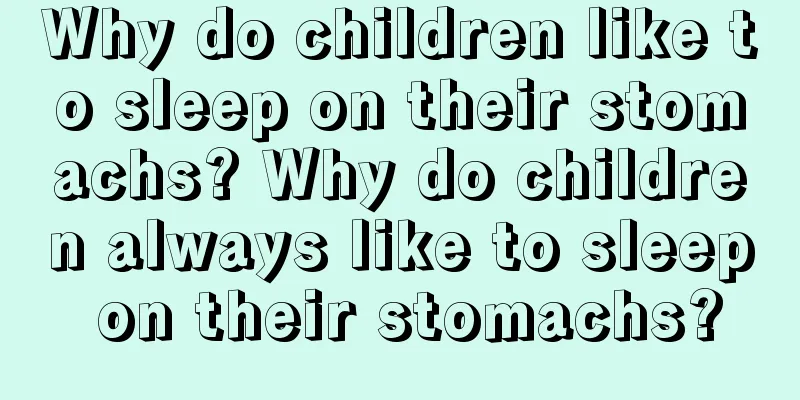What should I do if my baby has yellow hair? What is the reason for my baby's yellow hair?

|
The baby's hair is sparse, soft and yellow. Mothers are very distressed about this and worry that the baby's hair will not look good in the future. In fact, there is no need to worry about this because it is only a short-term physiological phenomenon for the newborn baby. What should I do if the baby's hair is yellow? What is the reason for the baby's hair to be yellow? The reason why children's hair turns yellowWhen children are young, their nutritional needs are very high. Most children's hair grows slowly, which is related to nutrition. As long as they have adequate nutrition in the later stage, their hair will grow quickly. But some children's hair doesn't grow well until they are 1 and a half years old. In addition, many children's hair growth is similar to that of their parents when they were young. Generally speaking, a child's hair color and length are related to genetics, but acquired factors are also important. For example, nutritional status, anemia, malnutrition such as vitamin and trace element deficiency, and even very rare congenital metabolic diseases will have an impact. In addition, it is also common for children's hair to gradually change from sparse and yellow to the black and thick hair it should be as they grow up. It is recommended to go to the hospital or health center to check for anemia, malnutrition or deficiency of trace elements such as zinc, etc. Due to genetic factors, many children's hair color is the same as their parents' when they were young, and it will gradually turn darker as they grow older. Nutritional factors. The color of children's hair is related to the protein, vitamins, and trace elements they consume. For example, children who are iron or zinc deficient will have yellow, dull, and sparse hair. Children who lack protein will also have poor hair quality. Children's early growth and development is very rapid, and the nutrition they consume often cannot meet the needs of rapid growth, especially the tall and fat children we see. Therefore, for such children, we need to pay attention to the nutrients they consume to ensure their further growth needs. As the child's nutritional needs are met, his hair will gradually become darker and brighter. Changes in children's hair are closely related to diseases and nutritional status. Generally speaking, malnutrition in the womb can make the baby's hair sparse, thin and soft, in clumps. Babies with rickets often have sparse hair near the pillow when they grow to 7-8 months old, accompanied by symptoms such as excessive sweating and itchy scalp. Infants with malnutrition generally have hair that is dry, yellow, dull, and easy to fall off. They also have slow nail growth, dry and cold skin, or goose bumps. There is also a genetic disease caused by inbreeding - phenylacetonidosis. The hair of children with this disease becomes yellower as they grow longer, and their complexion becomes delicate and pale, their urine smells like rat urine, and their intellectual development is not sound. |
<<: How to take care of roseola infantum? What are the symptoms of roseola infantum?
Recommend
Can babies eat salt when they have diarrhea? Can babies use salt hot compresses on their stomachs when they have diarrhea?
It is quite common for babies to have diarrhea, b...
Can I use skin care products during the confinement period? Can I use skin care products during the confinement period?
Confinement is a very important stage for women. ...
How to eliminate the fear of prenatal pregnancy
The day of delivery is coming soon. Expectant mot...
Baby bedtime story: Little penguin also has dreams
The little penguin is so cute, and it grows up wi...
What are the taboos during the confinement period? What should you eat during the confinement period?
The confinement period is a good time for women t...
What should I do if my baby likes to scribble at home?
Babies like to scribble on the walls everywhere, ...
How to reduce the pain of childbirth? Is painless childbirth really painless?
Childbirth is something every mother looks forwar...
Can I keep the baby without taking medicine if my progesterone level is low? Can I take Chinese medicine to treat low progesterone?
Low progesterone needs to be treated in time, oth...
What causes baby colic and how to relieve colic
A few weeks after birth, babies will start to cry...
Is it really useful to go to a beauty salon to get a facial?
Nowadays, many beautiful women like to go to beau...
Can babies eat green dates? Can babies eat more green dates?
When babies start to grow teeth, they like to be ...
Do I need to wash off the pregnancy oil? Do I need to apply the pregnancy oil every day?
We all know that pregnancy oil helps pregnant mot...
What should I eat if I want to have twins? What nutrients should I supplement for twins?
Some couples want twins very much, but one child ...
Is it okay to have a baby bed without paint? The wood will easily become soft and rot.
No, without the protection of paint, the wood wil...
Is it better to choose an electric or manual breast pump according to your own situation?
Choose according to your own situation. Electric ...









